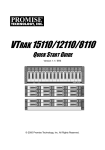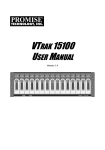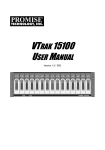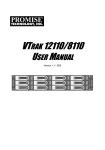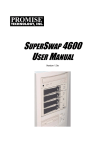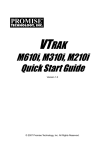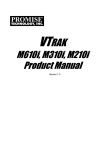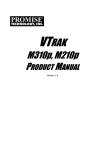Download Promise Technology M200i Network Card User Manual
Transcript
VTRAK M310p, M210p Quick Start Guide Version 1.1 © 2006 Promise Technology, Inc. All Rights Reserved. VTrak M310p, M210p Quick Start Guide VTrak M310p, M210p Task List Step 1: Unpack the VTrak (below). Step 2: Mount VTrak in a Rack (page 4) Step 3: Install Disk Drives (page 4) Step 4: Network and Data Cable Connections (page 6) Step 5: Set Up Serial Cable Connections (page 7) Step 6: Connect the Power (page 7) Step 7: Set IP Address with CLI or CLU (page 8) Step 8: VTrak Setup with Embedded WebPAM (page 12) Step 1: Unpack the VTrak The VTrak box contains the following items: • VTrak Unit • Quick Start Guide • Null Modem Cable • 1.0m External VHDCI SCSI cable (2 for M310p; 1 for M210p) • Screws for disk drives (52 for M310p; 36 for M210p; including 4 spares) • 1.5m (4.9 ft) Power cords (2 for US and 2 for Europe) • Mounting rail sets (1 pair) • CD with SNMP files, Product Manual and Quick Start Guide Warning The electronic components within the VTrak disk array are sensitive to damage from Electro-Static Discharge (ESD). Observe appropriate precautions at all times when handling the VTrak or its subassemblies. Important Use the following categories of network cables with VTrak: • Cat 6, preferred • Cat 5E, minimum 2 Step 1: Unpack the VTrak Power FRU Status Disk Array Status RAID Controller Activity Reserved Controller Heartbeat Figure 1. VTrak M310p Front View (M210p is similar) Power Supply 1 Cooling Unit 1 Cooling Unit 2 Power Supply 2 O O I I CONSOLE Mgmt RAID Controller Figure 2. VTrak M310p/M210p Rear View 3 VTrak M310p, M210p Quick Start Guide Step 2: Mount VTrak in a Rack The VTrak M310p/M210p subsystem installs directly to the rack with or without using the optional mounting rails. Refer to Chapter 2 of the VTrak Product Manual on the software CD for instructions on installing the rails and mounting your VTrak. Step 3: Install Disk Drives You can populate the VTrak with 1.5 GB or 3.0 GB SATA drives. Refer to Chapter 7 of the VTrak Product Manual on the software CD for the number of drives needed for each RAID configuration. Install all of the drive carriers into the VTrak enclosure to ensure proper airflow, even if you do not populate all the carriers with disk drives. If you use different size disk drives in the same logical drive, the total size of the logical drive will equal the size of the smallest disk drive times the number of drives. Refer to Chapter 2 of the VTrak Product Manual on the software CD for diagrams showing how the drive slots are numbered. Caution Use only the counter-sink screws supplied with the VTrak. Use of other types of screws can damage the adjacent drives. Counter-sink screws only. WARNING: SATA Drive Mounting Holes SATA Drive Mounting Holes Figure 3. VTrak M310p/M210p drive carrier mounting holes 4 Step 3: Install Disk Drives Serial ATA Disk Drive Figure 4. SATA Disk Drives mount at the front of the carrier Note Unlike other VTrak models, the M310p and M210p do not support Parallel ATA disk drives. There is no PATA-to-SATA adapter available for these models. 5 VTrak M310p, M210p Quick Start Guide Step 4: Network and Data Cable Connections Network Switch Management Port O O I I CONSOLE In Mgmt In Out Out VTrak In connector SCSI Channel (1 of 2) NIC SCSI HBA Card PC/Server Figure 5. VTrak M310p/M210p DAS connections This arrangement requires: • A network switch • A network interface card (NIC) in the PC • A SCSI HBA card in the PC • A SCSI cable that fits your HBA card and has a VHDCI connector to fit the VTrak SCSI channel VTrak’s SCSI connectors are bi-directional. However, the internal termination feature works only on the “Out” connector. Internal termination is set to “Automatic” by default. Connect the PC’s standard NIC and VTrak’s Management Port to your network switch to establish the management path. Connect a SCSI cable to the PC’s SCSI HBA card and one of the VTrak’s SCSI channels. To use the internal termination feature, attach the SCSI cable to the “In” connector. An external terminator is not required for this arrangement. If you plan to connect multiple VTraks on a SCSI chain, connect the other side of the same SCSI channel on the first VTrak to a SCSI channel on the second VTrak. See Chapters 4 or 5 of the VTrak Product Manual on the software CD for more information. 6 Step 5: Set Up Serial Cable Connections Step 5: Set Up Serial Cable Connections The RS-232 Serial connection enables the Command Line Utility (CLU) on your PC to monitor and control VTrak. DB-9 Serial Connector CONSOLE O Mgmt O I I CONSOLE Mgmt Figure 6. Serial connector for VTrak M310p/M210p Step 6: Connect the Power Plug the power cords and switch on both power supplies on. When the power is switched on, the LEDs on the front of the VTrak will light up. Power FRU Status Logical Drive Status RAID Controller Activity Reserved Controller Heartbeat Figure 7. VTrak M310p/M210p front panel LED display When boot-up is finished and the VTrak is functioning normally: 7 VTrak M310p, M210p Quick Start Guide • Controller Heartbeat LED blinks green seven times in three seconds, goes dark for six seconds, then repeats the blink pattern. • Power, FRU and Logical Drive LEDs display green continuously. • Fibre Channel/iSCSI/SCSI LEDs flash green if there is activity on that channel. There are two LEDs on each Drive Carrier. They report the presence of power and a disk drive, and the current condition of the drive. Disk Status Power/Activity Figure 8. VTrak M310p/M210p disk carrier LEDs After a few moments the Power/Activity should display Green. If there is no disk drive in the carrier, the Disk Status LED and the Power/Activity LED will remain dark. Step 7: Set IP Address with CLI or CLU VTrak has a Command Line Interface (CLI) to manage all of its functions, including customization. A subset of the CLI is the Command Line Utility (CLU), a user-level interface that manages your VTrak via your PC’s terminal emulation program, such as Microsoft HyperTerminal. You will use the CLU to assign an IP address to the VTrak for WebPAM. 1. 2. Change your terminal emulation program settings to match the following: • Bits per second: 115200 • Data bits: 8 • Parity: None • Stop bits: 1 • Flow control: none Start your PC’s terminal VT100 or ANSI emulation program. 3. Press Enter once to launch the CLI. 4. At the Login prompt, type administrator and press Enter. 5. At the Password prompt, type password and press Enter. 8 Step 7: Set IP Address with CLI or CLU At this point, you are in the CLI. You can continue using the CLI to make network settings or you can switch to the CLU. • CLI (below) • CLU (page 10) CLI 1. Type the following string to set the Management Port IP address and other settings, then press Enter. administrator@cli> net -a mod -t mgmt -s "primaryip=192.168.10.87, primaryipmask=255.255.255.0, gateway=192.168.10.3" In the above example, the IP addresses and subnet mask are included as examples only. Your values will be different. If you prefer to let your DHCP server assign the IP address, type the following string, then press Enter. administrator@cli> net -a mod -t mgmt -s "dhcp=enable" 2. To verify the settings, type net and press Enter. administrator@cli> net =========================================== CId Port Type IP Mask Gateway Link =========================================== 1 1 Mgmt 192.168.10.87 255.255.255.0 192.168.10.3 Up This completes the Management port setup. Go to “Step 8: VTrak Setup with Embedded WebPAM” on page 12. To see the full set of CLI commands, at the admin@cli> prompt, type help and press Enter. 9 VTrak M310p, M210p Quick Start Guide CLU 1. At the admin@cli prompt, type menu and press Enter. The CLU main menu appears. 2. With Quick Setup highlighted, press Enter. The first Quick Setup screen enables you to make Date and Time settings. System Date and Time 1. Press the arrow keys to highlight System Date. 2. Press the backspace key to erase the current date. 3. Type the new date. 4. Follow the same procedure to set the System Time. 10 Step 7: Set IP Address with CLI or CLU 5. Press Ctrl-A to save these settings and move to the Management Port configuration screen. Management Port By default, DHCP is enabled on VTrak (above). To set Management Port settings manually, or to view the current settings, you must disable DHCP. To view the current Management Port settings: 1. Press the arrow keys to highlight DHCP. 2. Press the spacebar to toggle to Disabled. The current Management Port IP are displayed (above). 3. Record the information on this screen. 4. Press the spacebar to toggle DHCP back to Enable. 11 VTrak M310p, M210p Quick Start Guide 5. Press Ctrl-A to save these settings and move to the RAID configuration screen. To make Management Port settings manually: 1. Press the arrow keys to highlight DHCP. 2. Press the spacebar to toggle to Disabled. 3. Press the arrow keys to highlight IP Address. 4. Press the backspace key to erase the current IP Address. 5. Type the new IP Address. 6. Follow the same procedure to specify the Subnet Mask, Gateway IP Address and DNS Server IP Address. If you do not have a DNS server, skip the DNS Server IP address. 7. Press Ctrl-A to save these settings. Exit the CLU 1. Highlight Skip the Step and Finish and press Enter. 2. Highlight Return to CLI and press Enter. This completes the Management port setup. Go to “Step 8: VTrak Setup with Embedded WebPAM” on page 12. Step 8: VTrak Setup with Embedded WebPAM Note You can also use the CLU to create disk arrays and logical drives. See Chapter 5 of the VTrak Product Manual on the software CD for more information. Set up with WebPAM consists of the following: • Log-in to WebPAM (below) • Language Selection (page 16) • Create a Disk Array (page 16) • Additional Logical Drives (page 25) • Log-out of WebPAM (page 25) • Internet Connection using WebPAM (page 26) 12 Step 8: VTrak Setup with Embedded WebPAM Log-in to WebPAM 1. Launch your Browser. 2. In the Browser address field, type in the IP address of the VTrak Management port. Use the IP address you obtained in Step 7 (see page 11). Note that the IP address shown below is only an example. The IP address you type into your browser will be different. Regular Connection • WebPAM uses an HTTP connection . . . . . . . . . . . . . . . . . . . . .http:// • Enter the VTrak’s Management Port IP address . . . 192.168.10.148 Together, your entry looks like this: http://192.168.10.148 Secure Connection • WebPAM uses a secure HTTP connection . . . . . . . . . . . . . . .https:// • Enter the VTrak’s Management Port IP address . . . 192.168.10.148 Together, your entry looks like this: https://192.168.10.148 Note Whether you select a regular or a secure connection, your login to WebPAM and your user password are always secure. 13 VTrak M310p, M210p Quick Start Guide . 3. When the opening screen appears, type administrator in the User Name field and type password in the Password field. The User Name and Password are case sensitive. 4. Click the Login button. After sign-in, the WebPAM opening screen appears (next page). If there are any unconfigured physical drives in the enclosure, the Array Configuration menu will also appear (see page 16). Important As soon as possible, assign the Administrator's password. Make the change under User Management. Each user you create will have his/her own login ID and password. Note Make a Bookmark (Netscape Navigator) or set a Favorite (Internet Explorer) of the Login Screen so you can access it easily next time. 14 Step 8: VTrak Setup with Embedded WebPAM The first time you log in to WebPAM, there will be no Users except for “administrator”. There will be no disk arrays or logical drives. Logged-in User Subsystem (IP address) Administration Tools User Management Network Management SCSI Management Storage Services Software Management Controller Group Enclosure Group Disk Array Group Spare Drive Group Logical Drive Summary Use the Tree to navigate to the various functions of WebPAM. Click on an item in the Tree to display it in the window. 15 VTrak M310p, M210p Quick Start Guide Language Selection WebPAM displays in English, German, French, Italian, Japanese, Chinese Traditional, Chinese Simple and Korean. 1. Click on Language in the WebPAM Header. The language list appears in the Header. 2. Click on the language you prefer. The WebPAM user interface will display in the selected language. Create a Disk Array Click on the Disk Arrays icon. The Array Configuration menu appears. Since this VTrak is newly activated, there are no disk arrays or logical drives yet. There are three options: Automatic, Express and Advanced. Select one and click the Next button. Or select one from the dropdown menu on the Create tab. Automatic The Disk Array Automatic Creation option enables you to create a new disk array following a default set of parameters. One logical drive will be made automatically when you create the disk array. 16 Step 8: VTrak Setup with Embedded WebPAM The number of unconfigured physical drives available will determine the RAID level of the disk array and whether a spare drive is created. When you choose the Automatic option, the following parameters display: • Disk Arrays – The number of physical drives in the disk array, their ID numbers, configurable capacity and the number of logical drives to be created • Logical Drives – The ID number of the logical drive(s), their RAID level, capacity and stripe size • Spare Drives – The physical drive ID number of the dedicated hot spare assigned to this disk array If you accept these parameters, click the Submit button. The new disk array appears in the Disk Array List on the Information tab. If you do NOT accept these parameters, use the Express (below) or Advanced (page 19) option to create your disk array. Express The Disk Array Express Creation option enables you to choose the parameters for a new disk array by specifying the characteristics you want. With this method, you can create multiple logical drives at the same time you create your disk array. However, all of the logical drives will be the same size and RAID level. If you prefer to specify the parameters directly, use the Advanced option to create your disk array. 17 VTrak M310p, M210p Quick Start Guide If you are uncertain about choosing parameters for your disk array, use the Automatic option. Follow these steps to create a new disk array. 1. 2. Check the boxes to select any one or a combination of: • Redundancy – The array will remain available if a physical drive fails • Capacity – The greatest possible amount of data capacity • Performance – The highest possible read/write speed • Spare Drive – A hot spare drive In the Number of Logical Drives field, enter the number of logical drives you want to make from this disk array. The maximum possible number of logical drives appears to the right of this field. 18 Step 8: VTrak Setup with Embedded WebPAM 3. 4. From the Application Type menu, select an application that best describes your intended use for this disk array: • File Server • Video Stream • Transaction Data • Transaction Log • Other Click the Update button. Or check the Automatic Update box and updates will occur automatically. The following parameters display: • Disk Arrays – The number of physical drives in the disk array, their ID numbers, configurable capacity and the number of logical drives to be created • Logical Drives – The ID number of the logical drive(s), their RAID level, capacity and stripe size • Spare Drives – The physical drive ID number of the dedicated hot spare assigned to this disk array If you accept these parameters, proceed to the next step. If you do NOT accept these parameters, review and modify your selections in the previous steps. 5. When you are done, click the Submit button. The new disk array appears in the Disk Array List on the Information tab. Advanced The Disk Array Advanced Creation option enables you to directly specify all parameters for a new disk array. If you select less than the total available capacity for the first logical drive, you can use the remaining space to create additional logical drives. An explanation of the choices you will make while using the Advanced option to create your disk array is included in Chapter 7 of the VTrak Product Manual on the software CD. If you are uncertain about choosing parameters for your disk array, use the Express or Automatic option to create your disk array. 19 VTrak M310p, M210p Quick Start Guide To create a new disk array: 1. Enter a name for the disk array in the field provided. 2. Check the box to enable the following features. 3. • Media Patrol – A routine maintenance procedure that checks the magnetic media on each disk drive. Media Patrol is concerned with the condition of the media itself, not the data recorded on the media. • PDM – Predictive Data Migration (PDM) scans the bad sector remapping table of the disk drives assigned to a logical drive. When the table fills to a specified percentage of its capacity, PDM triggers a migration of data from the suspect drive (the disk drive with the bad sectors) to a spare disk drive. Highlight physical drives you want in the disk array from the Available list and press the >> button to move them to the Selected list. You can also double-click them to move them. 4. When you are done, click the Next button. 20 Step 8: VTrak Setup with Embedded WebPAM On this screen you will specify your logical drives. Specify one logical drive at a time until the full capacity of the disk array is allocated. 5. Enter an Alias (name) for the first logical drive. 6. Choose a RAID level from the dropdown menu. The choice of RAID levels depends on the number of physical drives you selected. 7. Specify a Capacity and the unit of measure (MB, GB, TB). This value will be the data capacity of the logical drive. If you specify less than disk array's maximum capacity, the remainder is available for additional logical drives. 8. Specify a Stripe size from the dropdown menu. 8, 16, 32, 64, 128, 256, 512 KB and 1 MB are available. 64 KB is the default. 9. Specify a Sector size from the dropdown menu. 512 Bytes, 1, 2 and 4 KB are available. 512 Bytes is the default. 21 VTrak M310p, M210p Quick Start Guide 10. Choose a Read Cache policy: • ReadCache • ReadAhead • No Cache 11. Choose a Write Cache policy: • WriteThru • WriteBack 12. Click the Update button. When you click the Update button, WebPAM sets up one logical drive and adds it to the New Logical Drive lists at the bottom of the window. To create another logical drive, repeat steps 5 through 12, above. 22 Step 8: VTrak Setup with Embedded WebPAM If you want to change a logical drive setting, click on the logical drive at the bottom of the window. The entry and the capacity usage are highlighted. Make your changes to the parameters and click the Update button. 23 VTrak M310p, M210p Quick Start Guide 13. When you have finished specifying logical drives, click the Next button. 24 Step 8: VTrak Setup with Embedded WebPAM The proposed disk array appears with the logical drive(s) you specified. 14. If you agree with the proposed disk array and logical drive(s), click the Submit button. If you disagree, click the Back button and make changes as needed. Additional Logical Drives If you want to create additional logical drives and there is unused space on the current disk array, click on the Disk Array icon and click on the Create LD tab. You will go to Disk Array Advanced Creation (see page 19). If the current disk array is fully allocated, use additional physical drives to create a new disk array. Click on the Disk Arrays icon, then select Automatic, Express or Advanced from the Create tab dropdown menu (see page 16). Log-out of WebPAM There are two ways to log out of WebPAM: • Close your browser window • Click Logout on the WebPAM banner (below) Clicking Logout brings you back to the Login Screen. After logging out, you must enter your user name and password in order to log in again. 25 VTrak M310p, M210p Quick Start Guide Internet Connection using WebPAM The above instructions cover connections between VTrak and your company network. It is also possible to connect to a VTrak from the Internet. Your MIS Administrator can tell you how to access your network from outside the firewall. Once you are logged onto the network, you can access the VTrak using its IP address. While only a SCSI-capable PC can read and write data to the logical drives on the VTrak, other PCs can monitor the VTrak from virtually any location. Frequently Asked Questions What kind of disk drives can I use with VTrak? VTrak supports 1.5 and 3.0 Gb/s Serial ATA disk drives. Can I take the disk drives from my UltraTrak, put them into the VTrak and keep my disk array or logical drive intact? Yes. UltraTraks, except for JB4000, and early VTrak subsystems used a proprietary method of disk metadata, stored in the reserve sector of each physical drive. VTrak M310p/M210p use the industry-standard DDF and have a metadata-to-DDF conversion feature. To use the conversion feature, you must restart the VTrak M310p/M210p after installing disk drives from an older system. Note that if you move the disk drives from the VTrak M310p/M210p to the older subsystems, they will not recognize your disk array or logical drive. Can I use my existing SCSI card with VTrak M310p/M210p? Yes. For best performance results, use an Ultra320 SCSI card. How can I tell when the VTrak has fully booted? During the VTrak power-up process, the Power, FRU Status, and Logical Drive Status LEDs will light up. When the Logical Drive Status LEDs light up, the VTrak is fully booted. See pages 7 and 8. Why does VTrak come with a Command Line Utility? First, to assign your VTrak an IP address in order for the WebPAM management software to connect to it. Second, in the event of a network failure, you can still access the VTrak. Third, some users prefer the Command Line Utility. 26 Frequently Asked Questions My WebPAM connection was working OK. But later on, it timed out. What do I do now? The network condition can time-out for several reasons. When an open connection has no action for a specific amount of time (the Administrator can change it), the connection times-out automatically for security reasons. When you attempt to use WebPAM, it returns to the login screen. Enter your user name and password and click Login, and WebPAM will establish a new connection. I can access the VTrak over my company’s intranet. But I can’t access it from an outside Internet connection. How do I make the Internet connection work? This condition is not related to VTrak, but is due to your firewall and network connection protocol. Contact your MIS Administrator. With other Promise VTraks, I used the Server’s IP address in WebPAM to connect with the RAID subsystem. Why is this VTrak M310p/M210p different? VTrak M310p/M210p has the server software embedded. With the M310p/ M210p, you point your browser directly to the VTrak rather than a server. Also, with M310p/M210p you do not have to create a subsystem because the subsystem already exists. Why can a RAID 1 logical drive on VTrak consist of only two disk drives? On VTrak, RAID 1 logical drives work in mirrored physical drive pairs. You could create up to seven RAID 1 logical drives. Or you can create a single RAID 10 logical drive with data mirroring and up to 12 physical drives. If you have an odd number of drives but still want data mirroring, use RAID 1E. See the VTrak Product Manual on the software CD for more information on the number of physical drives you can use for each RAID level. Are logical drives on VTrak limited to 2.199 terabytes? No. But verify that your operating system supports logical drives over 2.199 TB. Also, for the operating system to recognize the full capacity of logical drives over 2.199 TB, you must specify a sector size of 1 KB or larger when you create the logical drive. See Chapter 7 of the VTrak Product Manual on the software CD for more information. I have two UltraTraks and use WebPAM to monitor them. Can I use my existing WebPAM setup to monitor the VTraks also? No. Use the WebPAM embedded with the VTrak M310p/M210p. 27 VTrak M310p, M210p Quick Start Guide How can I be sure everything is working OK on the VTrak? Locally: The VTrak enclosure has LEDs on the front to monitor the status of power, field replaceable units (FRUs) and logical drives. When these are green, VTrak is functioning normally. Remotely: Check the Tree Icons in WebPAM. If there are no yellow or red warning icons displayed, VTrak is functioning normally. What happens if a logical drive goes critical? On the front of VTrak, the logical drive LED turns amber and an audible alarm sounds. This condition is described in Chapter 4 of the VTrak Product Manual on the software CD. Can VTrak run using just one power supply? Yes, it is possible to run VTrak on a single power supply. There are two power supplies so that VTrak will continue running if one of the power supply fails. But deliberately leaving one power supply off negates this advantage. In addition, leaving one power supply off reduces air flow through the VTrak enclosure and can contribute to overheating. Always switch on both power supplies. Contact Technical Support Promise Technical Support provides several support options for Promise users to access information and updates. We encourage you to use one of our electronic services, which provide product information updates for the most efficient service and support. If you decide to contact us, please have the following information available: • Product model and serial number • BIOS, firmware and driver version numbers • A description of the problem / situation • System configuration information, including: motherboard and CPU type, hard drive model(s), SATA/ATA/ATAPI drives & devices, and other controllers. Technical Support Services Promise Online™ Web Site Promise Online™ eSupport http://www.promise.com/support (technical documents, drivers, utilities, etc.) https://support.promise.com/support (online request form) 28 Contact Technical Support United States E-mail Support [email protected] Fax Support (408) 228-1097 Attn: Technical Support Phone Support (408) 228-1400 option 4 If you wish to write us for support: Promise Technology, Inc. 580 Cottonwood Drive Milpitas, CA 95035, USA Europe, Africa, Middle East E-mail Support [email protected] Fax Support +31 (0) 40 256 9463 Attn: Technical Support Phone Support +31 (0) 40 235 2600 If you wish to write us for support: Promise Technology Europe B.V. Science Park Eindhoven 5542 5692 EL Son, The Netherlands Germany E-mail Support [email protected] Fax Technical Support +49 (0) 2 31 56 76 48 - 29 Attn: Technical Support Phone Technical Support +49 (0) 2 31 56 76 48 - 10 If you wish to write us for support: Promise Technology Germany Europaplatz 9 44269 Dortmund, Germany Italy E-mail Support [email protected] Fax Support 0039 06 367 12400 Attn: Technical Support Phone Support 0039 06 367 12626 If you wish to write us for support: Promise Technology Italy Piazza del Popolo 18 00187 Roma, Italia 29 VTrak M310p, M210p Quick Start Guide Taiwan E-mail Support [email protected] Fax Support +886 3 578 2390 Attn: Technical Support Phone Support +886 3 578 2395 (ext. 8811) If you wish to write us for support: Promise Technology, Inc. 2F, No. 30, Industry E. Rd. IX Science-based Industrial Park Hsinchu, Taiwan, R.O.C. China E-mail Support [email protected] Fax Support +86-10-8857-8015 Attn: Technical Support Phone Support +86-10-8857-8085/8095 If you wish to write us for support: Promise Technology China Room 1205, Tower 3 Webok Time Center, No.17 South Zhong Guan Cun Street Hai Dian District, Beijing 100081, China Caution • There is a risk of explosion if the battery is replaced by the incorrect type. • Dispose of used batteries according to the instructions that accompany the battery. 30































